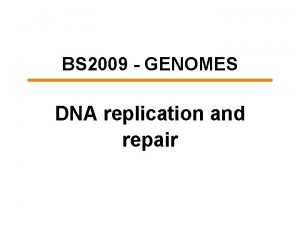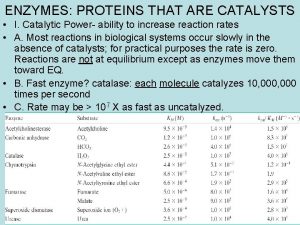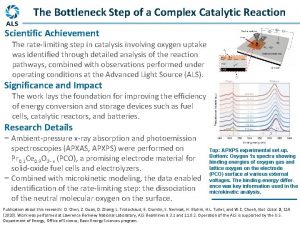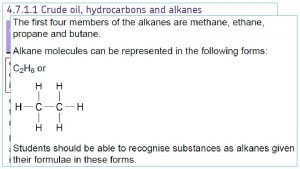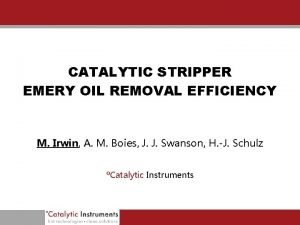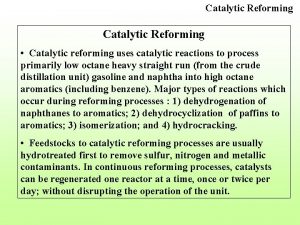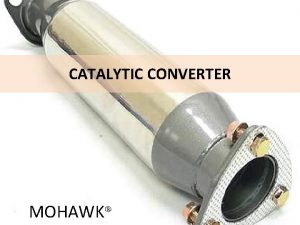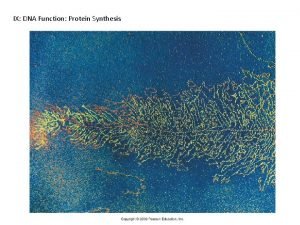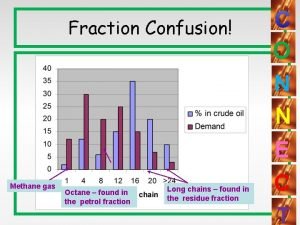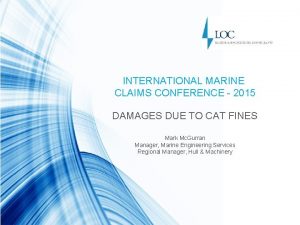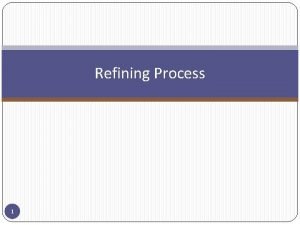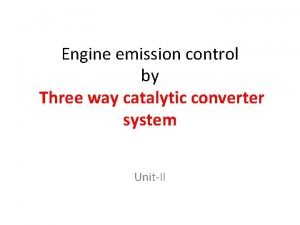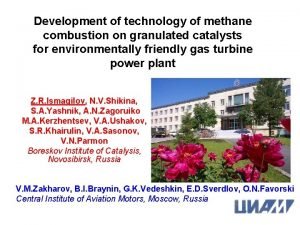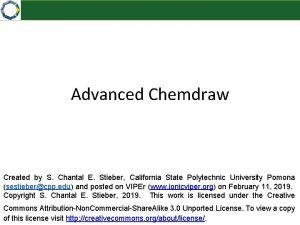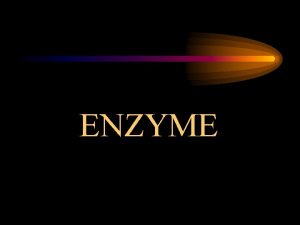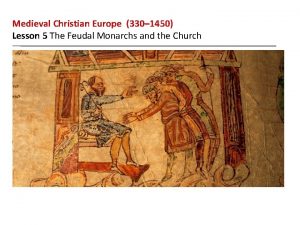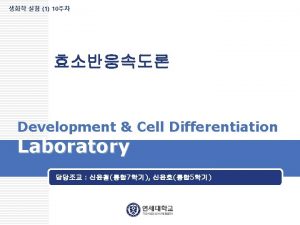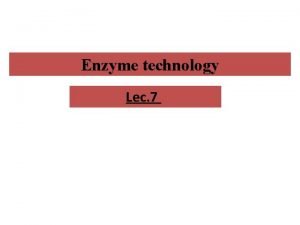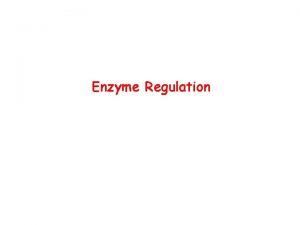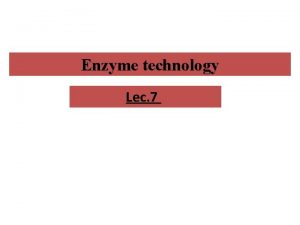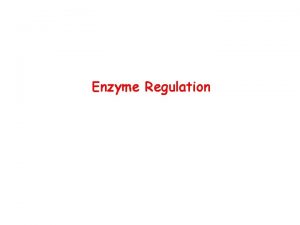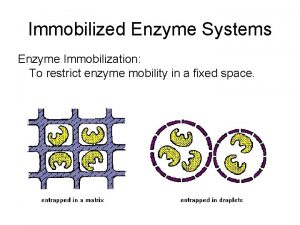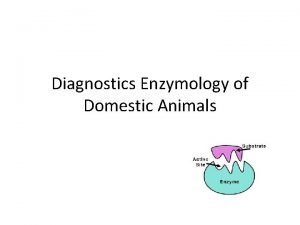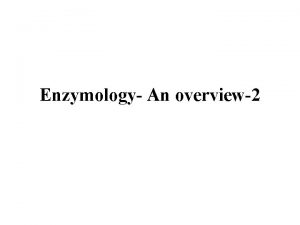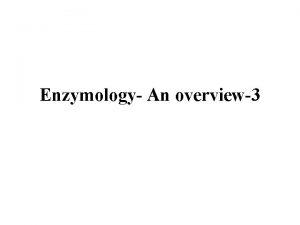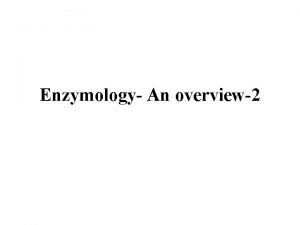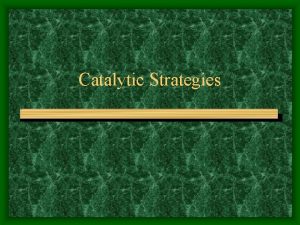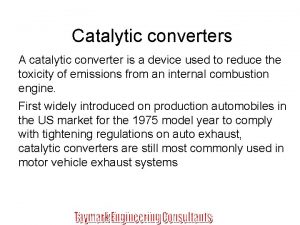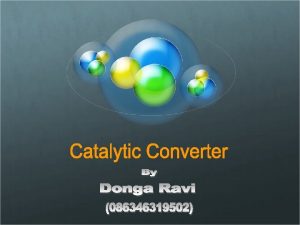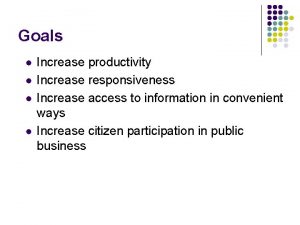Clinical Enzymology Introduction Enzyme Characteristics Catalytic power Increase




















- Slides: 20

Clinical Enzymology Introduction

Enzyme Characteristics Catalytic power Increase reaction rates by up to 1014 times Highly specific for their substrates No catalysis for closely related compounds Specific active site for substrate binding No by-products produced Regulation – regulated by interactions with Inhibitors – reversible or irreversible Activators – via presence of an activator or by permanent modification of the enzyme’s structure Huda S. Al. Bake, KSU, CAMS, 431 CLSHUDA S. Albakr CLS 431, KSU, CAMS, CLS Department 2

3/3/2021 Huda S. Al. Bake, HUDA S. Albakr KSU, CLS 431, CAMS, KSU, CAMS, CLS 431 CLSHUDA Department S. Albakr CLS 431, KSU, CAMS, CLS Department 3

Biological Catalysts Enzymes are protein catalysts (ribozymes are RNA They are required in small amounts They are not altered permanently by the reaction They do not change thermodynamics of a reaction They can only accelerate the rate at which a favorable reaction proceeds Huda S. Al. Bake, KSU, CAMS, 431 CLSHUDA S. Albakr CLS 431, KSU, CAMS, CLS Department catalysts) 4

Biological Catalysts A phosphatase enzyme can catalyze a rxn in 10 milliseconds Without the enzyme the rxn would take… 1 trillion yrs. (1, 000, 000) THE REACTION IS CONSIDERED SPONTANEOUS Huda S. Al. Bake, KSU, CAMS, 431 CLSHUDA S. Albakr CLS 431, KSU, CAMS, CLS Department Example: 5

Enzyme Nomenclature Huda S. Al. Bake, KSU, CAMS, 431 CLSHUDA S. Albakr CLS 431, KSU, CAMS, CLS Department Six classes of enzymes in Enzyme Commission (EC) 1. Oxidoreductases – redox reactions 2. Transferases – transfering functional groups 3. Hydrolases – hydrolysis reactions 4. Lyases – addition to double bonds 5. Isomerases – isomerization reactions 6. Ligases – formation of bonds with ATP cleavage Sub-class, sub-subclass – a code of four numbers is used to identify an enzyme Phosphofructokinase – X. X Factor X – X. X 6

3/3/2021 Huda S. Al. Bake, KSU, CAMS, 431 CLSHUDA S. Albakr CLS 431, KSU, CAMS, CLS Department 7

Coenzymes, Cofactors Many enzymes require other molecules for full enzymatic activity of Factor VIII (and Ca 2+ and phospholipids) in the blood clotting cascade Enzymes with co-factor present – holo-enzyme Enzymes without co-factor – apo-enzyme Huda S. Al. Bake, KSU, CAMS, 431 CLSHUDA S. Albakr CLS 431, KSU, CAMS, CLS Department Other proteins or small organic molecules Covalently bonded or non-covalently bonded Small molecules – vitamins, NAD+, NADH Other proteins/enzymes – Factor IX requires presence 8

3/3/2021 Huda S. Al. Bake, KSU, CAMS, 431 CLSHUDA S. Albakr CLS 431, KSU, CAMS, CLS Department 9

Huda S. Al. Bake, KSU, CAMS, 431 CLSHUDA S. Albakr CLS 431, KSU, CAMS, CLS Department 10

How do proteins catalyze reactions? A: Stabilizing transition state intermediate in the enzyme/substrate complex by base catalysis Electrostatic Covalent catalysis (forming intermediates) Proximity Strain interactions and orientation effects on chemical bonds Changes in reaction conditions Huda S. Al. Bake, KSU, CAMS, 431 CLSHUDA S. Albakr CLS 431, KSU, CAMS, CLS Department Acid 11

Enzyme-Substrate Complex and Active Site Huda S. Al. Bake, KSU, CAMS, 431 CLSHUDA S. Albakr CLS 431, KSU, CAMS, CLS Department Active site – region that binds substrates and cofactors Catalytic group – amino acids involved Promotes transition state stabilization 3 -d structure – cleft/crevice, and amino acids can be greatly separated in primary sequence Active site is a small fraction of molecular volume Substrates bound by multiple weak interactions 10 -2 to 10 -8 M eqm binding constants (-3 to -12 kcal/mol); covalent bonds are -50 to -110 kcal/mol Specificity depends on defined arrangement of atoms in active site. Lock and key or induced fit 12

Active sites Huda S. Al. Bake, KSU, CAMS, 431 CLSHUDA S. Albakr CLS 431, KSU, CAMS, CLS Department 13

Lock & Key Huda S. Al. Bake, KSU, CAMS, 431 CLSHUDA S. Albakr CLS 431, KSU, CAMS, CLS Department Induced Fit 14 14

How do enzymes catalyze? Huda S. Al. Bake, KSU, CAMS, 431 CLSHUDA S. Albakr CLS 431, KSU, CAMS, CLS Department Induced-fit model: Binding of the reactants (substrates) to the enzyme changes the enzyme’s structure The enzyme changes shape This change puts strain on the bonds of the reactants making them easier to break and rearrange The substrate(s) becomes twisted The strained reactants are said to be in a transition state 15

Induced Fit Model Huda S. Al. Bake, KSU, CAMS, 431 CLSHUDA S. Albakr CLS 431, KSU, CAMS, CLS Department 16

Thermodynamics review Std State = p. H 7 If H+ involved, its activity is 1 at std. state “Spontaneous” rxn G < 0 Huda S. Al. Bake, KSU, CAMS, 431 CLSHUDA S. Albakr CLS 431, KSU, CAMS, CLS Department 17

Substrate DG‡ Grxn DGcat‡ Product Reaction Coordinate Huda S. Al. Bake, KSU, CAMS, 431 CLSHUDA S. Albakr CLS 431, KSU, CAMS, CLS Department Free Energy G Thermodynamcs vs. Kinetics • Thermodynamics: Grxn determines if the reaction is spontaneous • Kinetics – activation energy barrier DG‡ determines the rate of reaction 18 • Catalyst/enzyme – lowers DG‡ by stabilizing the transition state, does not change the free energy of products or reactants

Kinetics review Huda S. Al. Bake, KSU, CAMS, 431 CLSHUDA S. Albakr CLS 431, KSU, CAMS, CLS Department 19 Enzymes increase rate of reaction by lowering

How do enzymes lower EA? Help Huda S. Al. Bake, KSU, CAMS, 431 CLSHUDA S. Albakr CLS 431, KSU, CAMS, CLS Department substrates get together: A reaction can’t occur unless substrates collide, enzymes help bring them together. Orient substrates: On their own, substrates collide randomly; enzymes bring them together in the proper orientation for the reaction to occur. Promote acid-base reactions: Enzyme may act like a H+ donor or acceptor to destabilize a bond. Exclude water: The removal of water may allow nonpolar or hydrophobic reactions to occur. 20
 Enzymology of replication
Enzymology of replication Ace-2 expression
Ace-2 expression Catalytic reformer bottleneck
Catalytic reformer bottleneck Catalytic air purifier
Catalytic air purifier Scott can industries
Scott can industries Covalent bond in ethanol
Covalent bond in ethanol Redox reaction in catalytic converters
Redox reaction in catalytic converters Emery oil
Emery oil Catalytic reforming of hexane
Catalytic reforming of hexane Catalytic converter ingredients
Catalytic converter ingredients Protein synthesis
Protein synthesis Cracking of octane
Cracking of octane Catalytic cracking
Catalytic cracking Naphthenes in crude oil
Naphthenes in crude oil Catalytic converter
Catalytic converter Site:slidetodoc.com
Site:slidetodoc.com Chantal stieber
Chantal stieber Power triangle diagram
Power triangle diagram Characteristics of enzyme
Characteristics of enzyme Class of enzyme
Class of enzyme Which actions did french kings take to increase royal power
Which actions did french kings take to increase royal power
